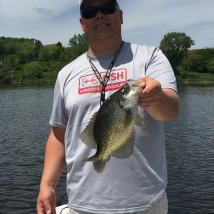
Super Speck. Nice crappies, like this 14-incher caught by Josh Holm, can be found when schools are encountered on Lake Ashtabula near Valley City. Simonson Photo.
By Nick Simonson
With lakes and rivers in the southeastern portion of North Dakota coming down from record high water levels in the fall and winter of 2019-2020, fishing for a variety of species in the region should still be good according to BJ Kratz, North Dakota Game & Fish Department (NDG&F) District Fisheries Supervisor.
Across a wide range of species, he advises anglers that these may be “the good old days” for the district from the small lakes within it which are stocked with walleye,s to good populations of crappies on popular reservoirs, to unique opportunities such as muskies now inhabiting area flows.
“We’re down in water a little bit, probably 12 to 18 inches on the average in a lot of our places, there isn’t much for flows in the rivers this year simply with the lack of runoff in general, but we’ve been in a lot worse shape for this time of year, so I’m optimistic,” Kratz stated.
Aside from one small impoundment that experienced a winterkill and a couple of water bodies that were close with lower dissolved oxygen levels, most fisheries benefitted from the relatively mild winter, decreased snow cover, and the early melt which occurred across the region. Most of those waters have also been buoyed by the increased stocking efforts by the NDG&F in recent years, and have limited natural reproduction in them, especially those smaller slough-style lakes which are now home to good populations of walleyes. While the lower water levels on some rivers and lakes may impact the limited natural reproduction which does occur, the stocking program will help pick up the slack and provide continued opportunities in seasons to come, especially for walleyes, the region’s most targeted fish. As it turns out, the lower water levels may help spur a bite this season.
Whacking Walleyes, Catching Crappies
“With the drier conditions and water levels receding, sometimes that creates better action in places, simply because you lose the productivity and you’re just shrinking your environment to produce food,” Kratz explains, “the adult fish are still there and they’re not going to perish in one year, so it condenses them a little bit and they become a little more potentially active for presentations rather than the natural food base,” he continues regarding the population of walleyes on those smaller lakes like the popular Mallard Marsh.
For crappies, the region’s bigger waters offer a good mix for anglers, as Jamestown Reservoir and Lake Ashtabula provide opportunities. Jamestown Reservoir has excellent shore fishing opportunities for anglers with a lot of fish between nine and 11 inches, with an occasional bigger slab available. Ashtabula, on the other hand has fewer numbers of crappies which may be tougher to find, but the chance of finding bigger fish is better when a school of specks is encountered. Searching shallower to start the season is a good bet for these popular panfish, according to Kratz.
Muskie Moves
After stocking muskellunge in Lake Ashtabula in 2016 and 2017, the NDG&F switched to adding tiger muskies – a hybrid between pure muskies and northern pike – to the reservoir in 2018 and 2019. With many of the agency’s early stockings of pure muskies now reaching lengths in the mid-30-inch range, the fishery is beginning to develop with the added wrinkle of the hybrids being added to the mix. The stocking switch was based more on a matter of availability than it was on variety, according to Kratz.
“Muskies have been stocked in Lake Ashtabula through the last several decades periodically and it was never very regularly and it certainly wasn’t very consistently in terms of sizes and so forth, sometimes it was small fingerlings, sometimes it might have been advanced fingerlings, sometimes it was fry,” Kratz explains, as larger fish have helped establish the species in the water, “we were able to come into some larger fish basically that started what we have now, and any time you can stock young adults, you’re money ahead so to speak in terms of their ability to survive in a new environment,” he continues regarding the size and numbers of the fish that are showing up.
The high waters of 2019 pulled a number of those larger muskies out of Lake Ashtabula through the spillway at Baldhill Dam, depositing them downstream in the Sheyenne River. While some of those fish have likely become established in the river and will likely be caught by anglers in the coming year and on down the road, Kratz says that anglers shouldn’t expect them to reach the epic proportions of 48 to 50 inches or more which they could get to in the lake, due the generally small size of the flow and its limited resources when it comes to their preferred abundance of food.
They will, however, remain an exciting catch for many searching for walleyes, smallmouth bass and pike which are prevalent in the river.
